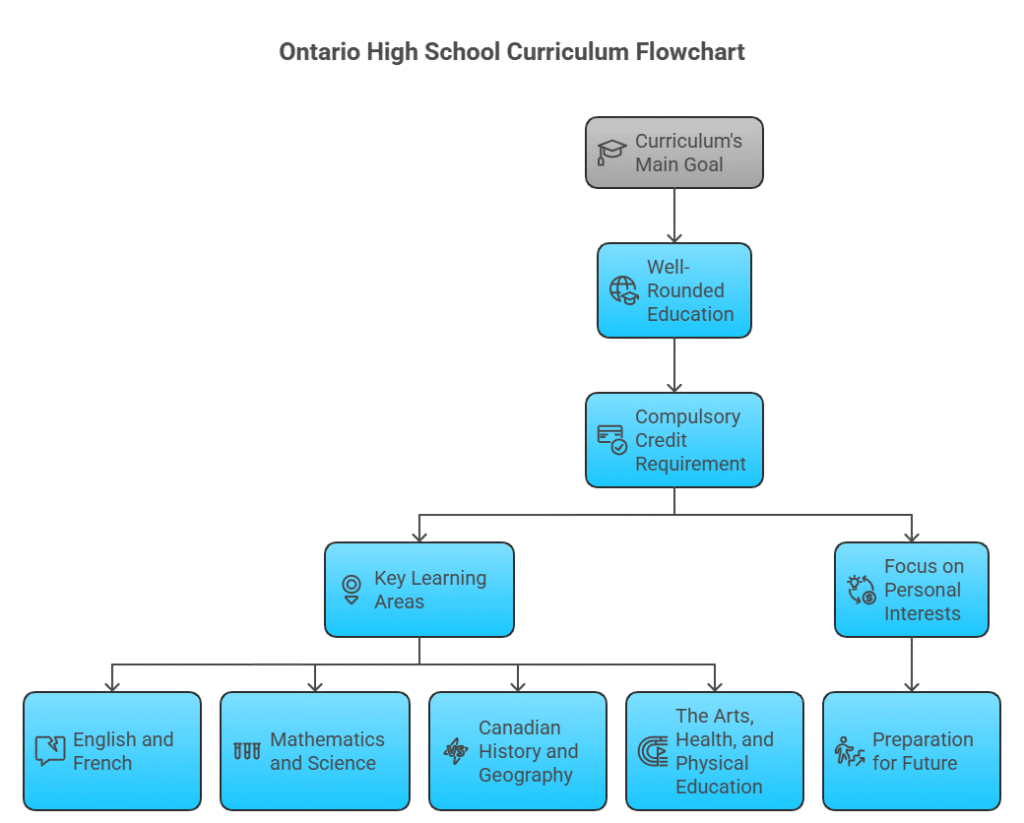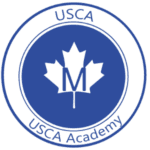Key Highlights of Ontario High School Curriculum
- To get an Ontario Secondary School Diploma (OSSD), you need to finish 30 credits.
- The curriculum at an Ontario secondary school comes with some compulsory credit courses that the Ministry of Education asks for.
- One main graduation requirement is to pass the literacy graduation requirement by taking the provincial literacy test or a similar course.
- You must complete 40 hours of community involvement to get your high school diploma.
- Students now also have to earn two online learning credits as part of the high school diploma requirements.
- A new financial literacy graduation requirement will be added for high school students in 2025.
Introduction
Going through the Ontario education system may seem hard, but knowing how to graduate is key. At an Ontario secondary school, you move toward your future, working to get the Ontario Secondary School Diploma (OSSD) through the Ontario high school curriculum. This guide will show you each step, from getting credits to finishing community service. It will help you and your family get ready for a good high school experience and what comes next. Use this as the map to help you earn your high school diploma.
Ontario High School Curriculum Overview (2025 Edition)
The Ontario high school program is put together by the Ontario Ministry of Education. It helps students get ready for university, college, or a job. In 2025, there will be new diploma requirements. This means it is important for students and parents to keep up with the latest information.
This Ontario curriculum guide makes things simple. It shows which courses and steps you need to take to finish high school and graduate. No matter if you are in a public school, private school, or a place like USCA Academy, the same rules from the ministry of education work for every Ontario secondary school student.
Structure of the Ontario Secondary School Diploma (OSSD)
- The Ontario Secondary School Diploma (OSSD) is the main credential for students in Ontario secondary schools, requiring 30 credits (17 required, 13 optional) for graduation.
- OSSD requirements are consistent across all school boards, ensuring every student receives a solid and equitable education, regardless of location, with flexibility to pursue individual interests.
- Both public and private/international schools, such as USCA Academy, are authorized by the Ministry of Education to grant the OSSD, which is recognized globally and opens doors to universities and colleges worldwide.
Key Curriculum Goals and Learning Areas

The curriculum’s main goal is to give you a well-rounded education in high school. You get skills to help you think better and gain knowledge in many different areas. The compulsory credit requirement makes sure you learn key things first. After you finish those, you can focus more on what you want in your later years at school.
These required courses help all students get what they need for the future. You will study the arts, sciences, and practical things like career education as well as physical education. This helps prepare you for life when you leave high school.
The compulsory subjects that are at the core of the Ontario high school curriculum include:
- English and French as a Second Language
- Mathematics and Science
- Canadian History and Canadian Geography
- The Arts, Health, and Physical Education
OSSD Requirements and Credit System
It is important to know about the diploma requirements. The Ontario credit system is key here. In this system, a credit is given when you finish a course with at least 110 hours of classes. Credit courses fall into two types: compulsory credit or optional credit.
To graduate, you need to plan which courses to take. The compulsory credit is needed to meet the diploma requirements. You can also pick credit courses that interest you as your optional credits. This way, you get to learn more about subjects you like while completing what is needed for your diploma.
Let’s see how the credits are split up and find out what other things you have to do to finish your diploma.
Compulsory and Elective Credits Breakdown
For students starting high school in fall 2024, graduating requires earning 17 compulsory credits and 13 elective credits. Compulsory credits cover essential subjects, while elective credits allow you to choose courses from your school’s course calendar that align with your interests and career goals.
The compulsory English requirement, for instance, consists of four credits, one for each grade. In addition to core subjects, you must also earn an additional credit from specific course groupings, such as a STEM-related field, to ensure a broad scope of learning.
Here is a summary of the compulsory credits you need to graduate:
| Subject Area | Credits Required |
|---|---|
| English | 4 |
| Mathematics | 3 |
| Science | 2 |
| Canadian History | 1 |
| Canadian Geography | 1 |
| The Arts | 1 |
| Health & Physical Education | 1 |
| French as a Second Language | 1 |
| Technological Education | 1 |
| Career Studies & Civics | 1 (0.5 each) |
| STEM-related Course | 1 |
Literacy Test and Community Involvement Hours
Beyond credits, there are two other important things you need to do before you can graduate from an Ontario secondary school. First, you have to meet the school literacy requirement. This shows that you have reading and writing skills. To meet this, you need to pass the Ontario Secondary School Literacy Test.
You also need to do community involvement. This means you have to finish at least 40 hours of community involvement activities. These hours help you learn how to give back to others and to grow as a person. It is not optional. You must do this to get your diploma.
In short, your graduation list for Ontario secondary school is:
- Get 30 credits in total (17 required, 13 you can choose)
- Pass the Ontario Secondary School Literacy Test or take the school literacy course
- Finish 40 hours of community involvement activities
- Do the online learning and financial literacy requirements
Course Types and Learning Pathways
The Ontario high school curriculum gives you many course options. This helps you find your own way in learning. The courses you take in Grades 9 and 10 help set you up for the next steps. When you get to Grades 11 and 12, what you choose lets you focus more. This is good if you plan to keep studying or start working after school.
You have to take some compulsory courses. You also get to pick from elective courses in areas like career studies. There are narrow options that let you follow your interests. The system is there to help you reach your goals. We will talk about how the course choices change as you move from junior to senior high school. We will also look at what other things are required for you to know in high school.
Grades 9–10: Academic, Applied, Open Courses
In Grade 9 and Grade 10, you can pick from different course types. These options are there to fit how you learn and what you want in the future. Academic courses teach theory and ideas. These are good if you want to get ready for university. Applied courses use real-life examples and hands-on work. These fit people who learn best by doing things. Open courses are for all students and help you learn more about a topic you like.
What you pick in these years matters. For example, taking academic math and science in Grade 10 is needed if you want to get into university classes in Grade 11 and Grade 12.
The main differences be in how you learn and where these classes can take you:
- Academic courses help you get ready for university.
- Applied courses help you get ready for college or job training.
- Open courses can make your learning stronger, for every student.
- What you choose will set up your path for senior grades.
Additional Mandatory Courses and Group Requirements
- To meet compulsory credit requirements, you must complete credits from specific course groups for a balanced education. Before Fall 2024, students chose one additional credit from humanities, business studies, and advanced sciences.
- Starting Grade 9 in 2024 or later, students must earn one compulsory credit in technological education, plus one more credit from STEM subjects such as business studies, computer studies, advanced mathematics, or cooperative education.
- Beginning September 2025, graduation requires passing a financial literacy module in Grade 10 mathematics with at least a 70% mark to qualify for the diploma.
Assessment and Graduation Criteria
Meeting the graduation requirement for an OSSD at an Ontario secondary school is about more than passing your classes. You need to do three main things for successful completion. You must earn all 30 high school credits. You have to meet the literacy graduation requirement by passing the school literacy test, and you need to finish the community involvement hours.
The way you are assessed is wide-ranging. The school looks at your course marks, and you have to take the Ontario Secondary School Literacy Test. Now, let’s look at the literacy test and the different course options you can pick in your last years of high school.
Ontario Secondary School Literacy Test (OSSLT) Requirement
The Ontario Secondary School Literacy Test (OSSLT) is the school literacy test that checks reading and writing by the end of Grade 9. Every student needs to pass this test to meet the literacy requirement for graduation. Most people take the Ontario Secondary School Literacy Test when they are in Grade 10.
If you do not pass the first time, you can take the test again. If you do not pass after two tries, you have another way to meet the literacy requirement. You can join the Ontario Secondary School Literacy Course (OLC4O). If you finish this Ontario secondary school literacy course, you meet the requirement and get an additional credit for your diploma.
You can find updates and details at the Ontario Ministry of Education website. Schools, such as USCA Academy, help students get ready for the Ontario Secondary School Literacy Test or support those who want to finish the OLC4O course.
Grades 11–12: University, College, Mixed, Workplace Streams
When you enter Grades 11 and 12, you choose courses that match your future plans. These are called streams, and your choices matter for what you do next. The university stream prepares you for university entrance, while the college stream focuses on skills for college programs. The mixed stream lets you take both university and college courses, keeping options open. The workplace stream builds skills for employment after high school. The courses you finish in these streams help you meet requirements for university, college, or work. Streams help you align your high school classes with your goals:
- University (U) courses
- University/College (M) courses
- College (C) courses
- Workplace (E) courses
Private and International Schools Offering the Ontario Curriculum
Many private and international schools now offer the Ontario curriculum because it’s trusted around the world. These schools follow the same standards as public schools in Ontario, helping students earn the Ontario Secondary School Diploma (OSSD). The curriculum focuses on real-world skills, project-based learning, and personal growth not just exams. International schools often work with Ontario-certified teachers or partner schools to deliver the program properly. This gives students a chance to get a Canadian education from anywhere.
How USCA Academy Implements the OSSD
USCA Academy is a private school in Mississauga, Ontario, approved by the Ministry of Education to grant the OSSD. It offers Grades 9–12 and supports both local and international students. Students complete 30 credits, do volunteer hours, and pass a literacy test to graduate. USCA Academy uses small class sizes and certified teachers to give students personal attention. International students get extra help with English and university applications. The school also offers online and fast-track options to meet different learning needs.
Benefits for Local and International Students
- The OSSD is accepted by top universities worldwide.
- Students learn through projects and assignments, not just final exams.
- International students can apply to Canadian universities as domestic applicants.
- ESL support helps non-native speakers succeed.
- The curriculum builds leadership, teamwork, and communication skills.
Whether studying in Canada or abroad, the Ontario curriculum helps students grow academically and prepare for future success.
Conclusion
The Ontario High School Curriculum is made to help students be ready for success later in life. The plan for the Ontario Secondary School Diploma (OSSD) has clear steps. Students can go through the required and extra courses so they finish all they need to graduate. Knowing how grades are given and looking at learning choices is important. It can help you pick the best path for school and work. If you stay active in your learning and ask teachers or counselors for help, you can get more out of high school. If you have questions, or need help, please reach out.
Frequently Asked Questions
1. How do course prerequisites work in Ontario high schools?
Course prerequisites are credit courses that you have to pass first, before you sign up for the next level. For instance, you need to finish compulsory english in Grade 10 before you move on to the Grade 11 course. The school board lists all these rules in its course calendar so that students get the right start.
2. Can Ontario high school credits be transferred from other provinces or countries?
Yes, the school can take credits you have from other education systems and let you use them at an Ontario secondary school. The principal will look at what you learned before. He will decide how many credits you get as transfer credits. These credits are checked with the Ontario Ministry of Education. The school will write these transfer credits on your official Ontario Student Transcript.
3. How is technology integrated into the Ontario high school curriculum?
Technology is now a part of every area in the Ontario curriculum. All students will need to finish two online learning credits before they can graduate. There are also special classes for technological education and computer studies. The ministry of education wants teachers and students to use different digital tools in their subjects to help with learning. You can read more about this in the ontario curriculum guide.
4. What role do guidance counsellors play in course selection and pathways?
Guidance counsellors are important in your time at high school. They help you pick courses so you have what you need to finish and move towards your goals. You can get help with career studies from them, and learn about colleges or jobs after high school. They also tell you about cooperative education and other ways to make your high school years better.









